The AMD Radeon R9 290X Review
by Ryan Smith on October 24, 2013 12:01 AM EST- Posted in
- GPUs
- AMD
- Radeon
- Hawaii
- Radeon 200
Hitman: Absolution
The second-to-last game in our lineup is Hitman: Absolution. The latest game in Square Enix’s stealth-action series, Hitman: Absolution is a DirectX 11 based title that though a bit heavy on the CPU, can give most GPUs a run for their money. Furthermore it has a built-in benchmark, which gives it a level of standardization that fewer and fewer benchmarks possess.
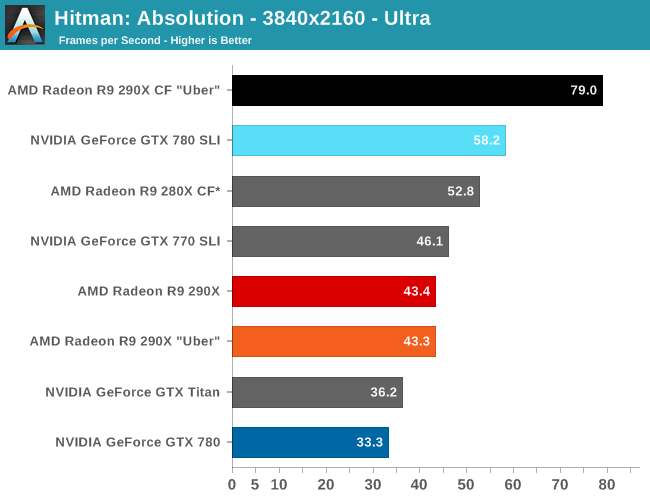

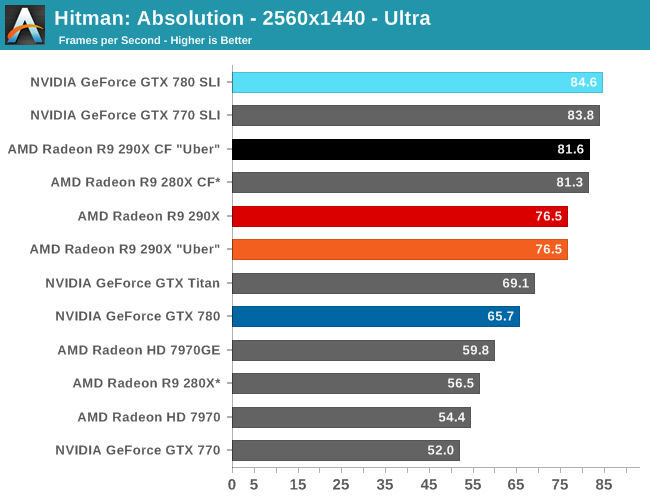
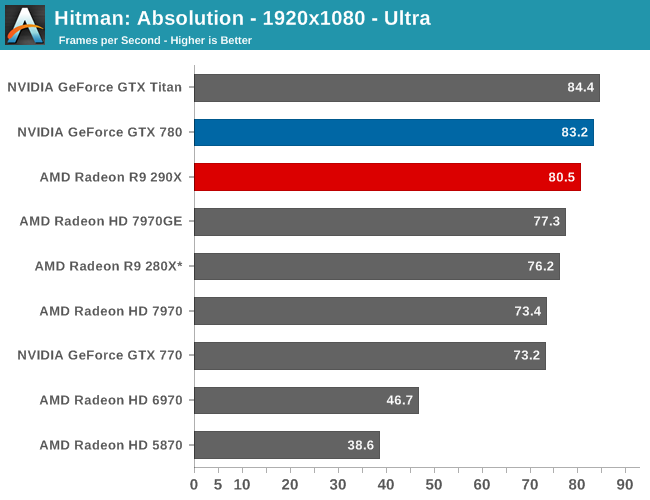
Hitman is another game that makes the 290X shine, with the 290X taking a 16% lead over the GTX 780. In fact we’re getting very close to being CPU limited here, which may be limiting just how far ahead the 290X can pull. However this also means there’s plenty of GPU headroom for enabling MSAA, which we don’t use in this benchmark.
Moving on to 4K, the 290X once again extends its lead, this time by among the largest such leads to 30% over the GTX 780. This is actually good enough for 43fps even at Ultra quality, but for better than that you’ll need multiple GPUs.
To that end we’re CPU limited at 2560, though for some reason the GTX 780 SLI fares a bit better regardless. Otherwise at 4K the GTX 780 SLI achieves better scaling than the 290X CF – 64% versus 56% –so while it can’t take the lead it does at least close the gap some. Though enough of a gap remains that the GTX 780 SLI will still come a bit short of 60fps at 4K Ultra settings, which makes the 290X CF the only setup capable of achieving that goal.
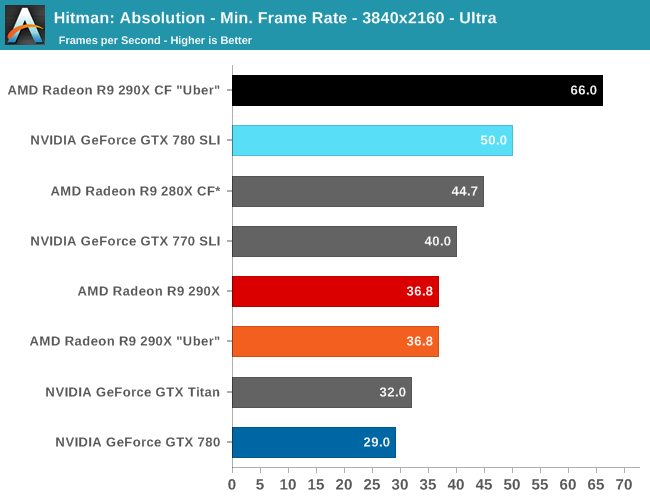

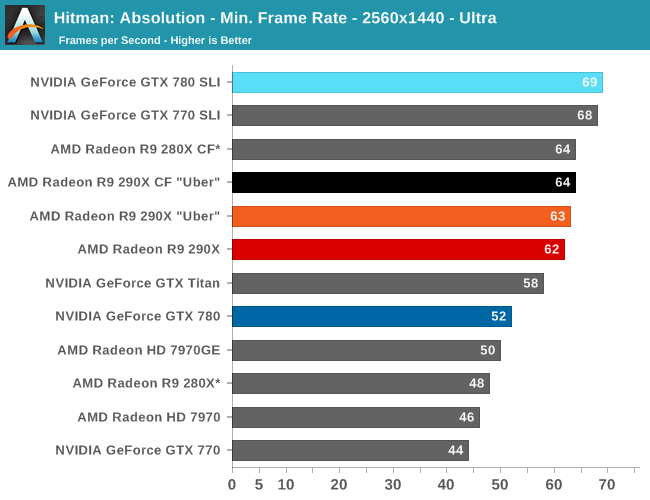
When it comes to minimum framerates the 290X is able to build on its lead just a bit more here at both 2560 and 4K. In both cases the performance advantage over the GTX 780 grows by a further 3%.

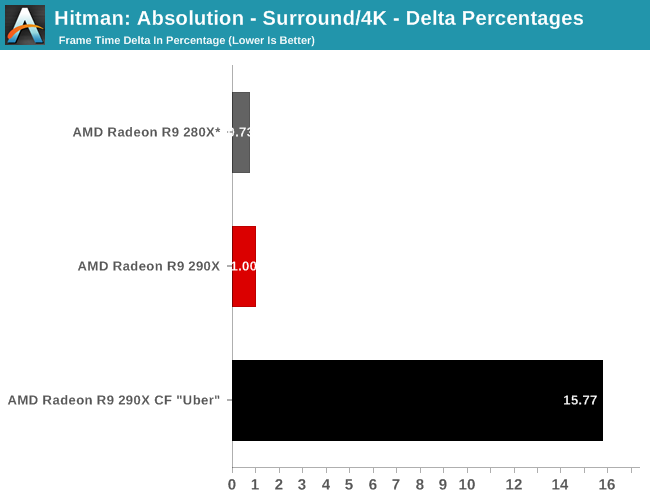
Finally, for our delta percentages we can see that unfortunately for AMD they are regressing a bit here. The variance for the 290X CF at 2560 is 24%, which is greater than what the 280X CF was already seeing, and significantly greater than the GTX 780 SLI. Consequently Hitman is a good example of how although AMD’s CF frame pacing situation is generally quite good, there are going to be games where they need to buckle down a bit more and get it under control, as evidenced by what NVIDIA has been able to achieve. Though it is interesting to note that AMD’s frame pacing at 4K improves over 2K, by over 8%. AMD would seem to have an easier time keeping frame times under control when they’re outright longer, which isn’t wholly surprising since it means there’s more absolute time to resolve the matter.


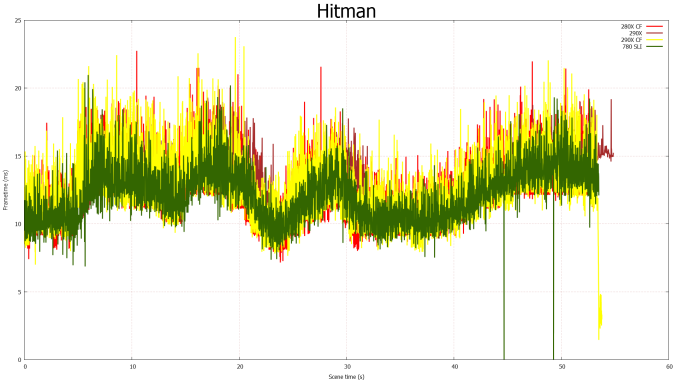
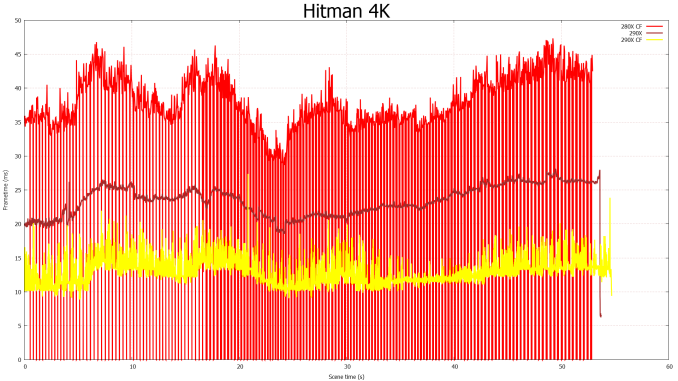








396 Comments
View All Comments
mr_tawan - Tuesday, November 5, 2013 - link
AMD card may suffer from loud cooler. Let's just hope that the OEM versions would be shipped with quieter coolers.1Angelreloaded - Monday, November 11, 2013 - link
I have to be Honest here, it is beast, in fact the only thing in my mind holding this back is lack of feature sets compared to NVidia, namely PhysX, to me this is a bit of a deal breaker compared for 150$ more the 780 Ti gives me that with lower TDP/and sound profile, as we are only able to so much pull from 1 120W breaker without tripping it and modification for some people is a deal breaker due to wear they live and all. Honestly What I really need to see from a site is 4k gaming at max, 1600p/1200p/1080p benchmarks with single cards as well as SLI/Crossfire to see how they scale against each other. To be clear as well a benchmark using Skyrim Modded to the gills in texture resolutions as well to fully see how the VRAM might effect the cards in future games from this next Gen era, where the Consoles can manage a higher texture resolution natively now, and ultimately this will affect PC performance when the standard was 1-2k texture resolutions now becomes double to 4k or even in a select few up to 8k depth. With a native 64 bit architecture as well you will be able to draw more system RAM into the equation where Skyrim can use a max of 3.5 before it dies with Maxwell coming out and a shared memory pool with a single core microprocessor on the die itself with Gsync for smoothness we might see an over engineered GPU card capable of much much more than we thought, ATI as well has their own ideas which will progress, I have a large feeling Hawaii is actually a reject of sorts because they have to compete with Maxwell and engineer more into the cards themselves.marceloviana - Monday, November 25, 2013 - link
I Just wondering why does this card came with 32Gb gddr5 and see only 4Gb. The PCB show 16 Elpida EDW2032BBBG (2G each). This amount of memory will help a lot in large scenes wit Vray-RT.Mat3 - Thursday, March 13, 2014 - link
I don't get it. It's supposed to have 11 compute units per shader engine, making 44 on the entire chip. But the 2nd picture says each shader engine can only have up to 9 compute units....?Mat3 - Thursday, March 13, 2014 - link
2nd picture on page three I mean.sanaris - Monday, April 14, 2014 - link
Who cares? This card was never meant to compute something.It supposed to be "cheap but decent".
Initially they made this ridiculous price, but now it is around 200-350 at ebay.
For $200 it worth its price, because it can be used only to play games.
Who wants to play games at medium quality (not the future ones), may prefer it.